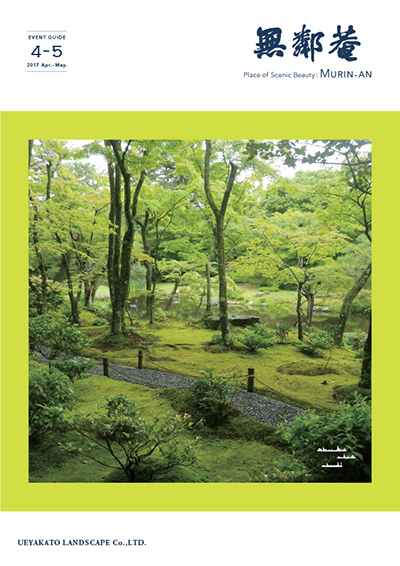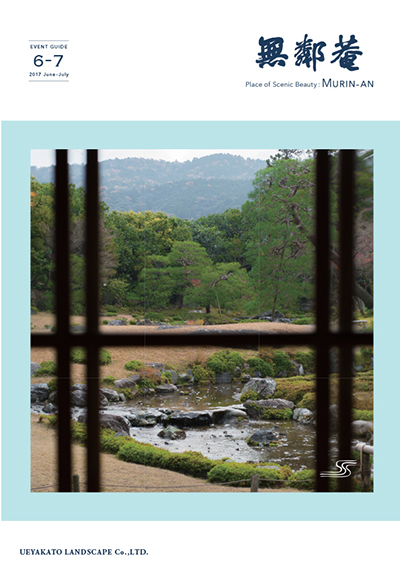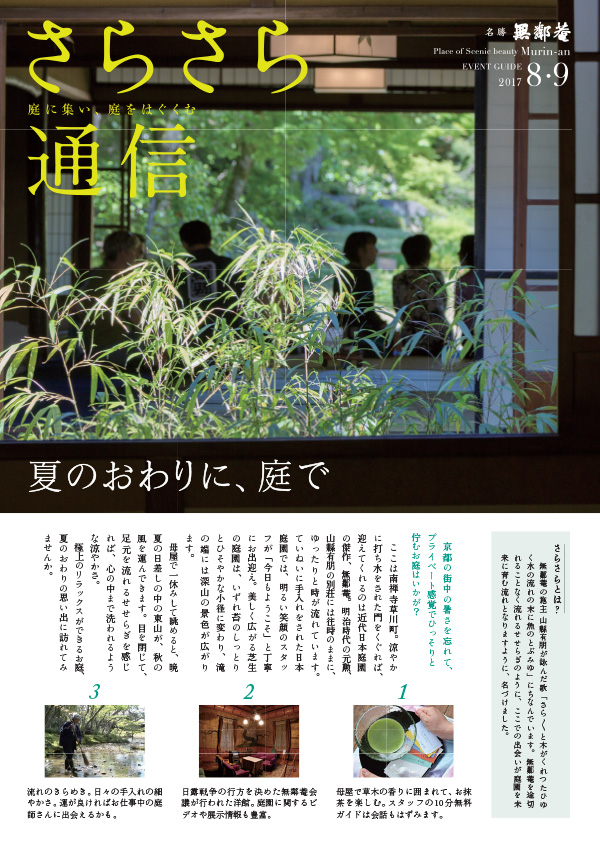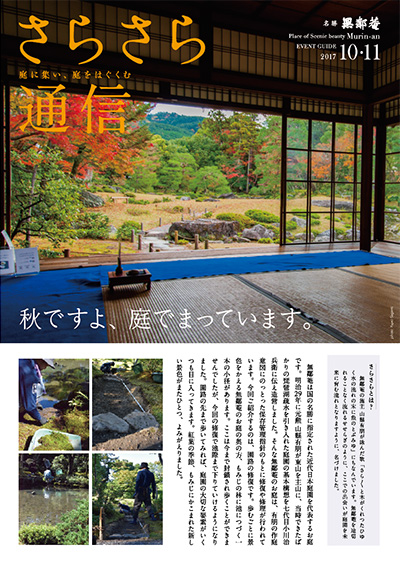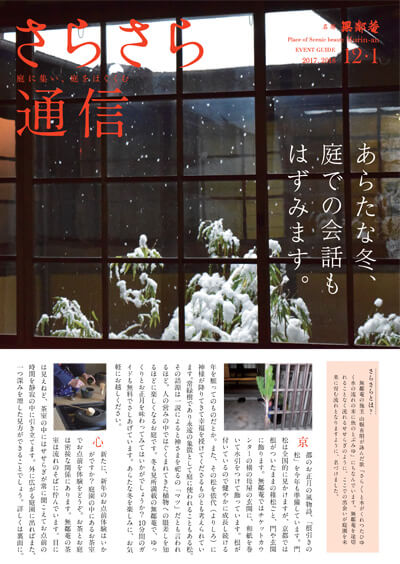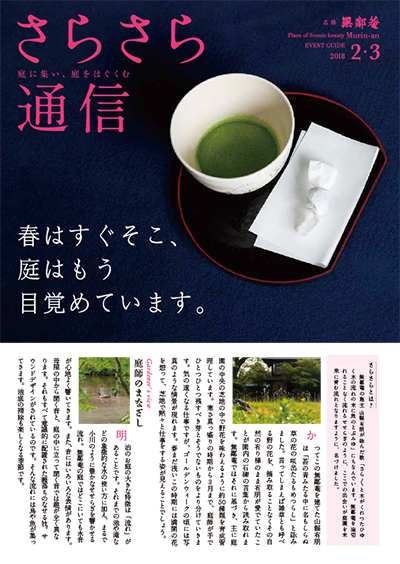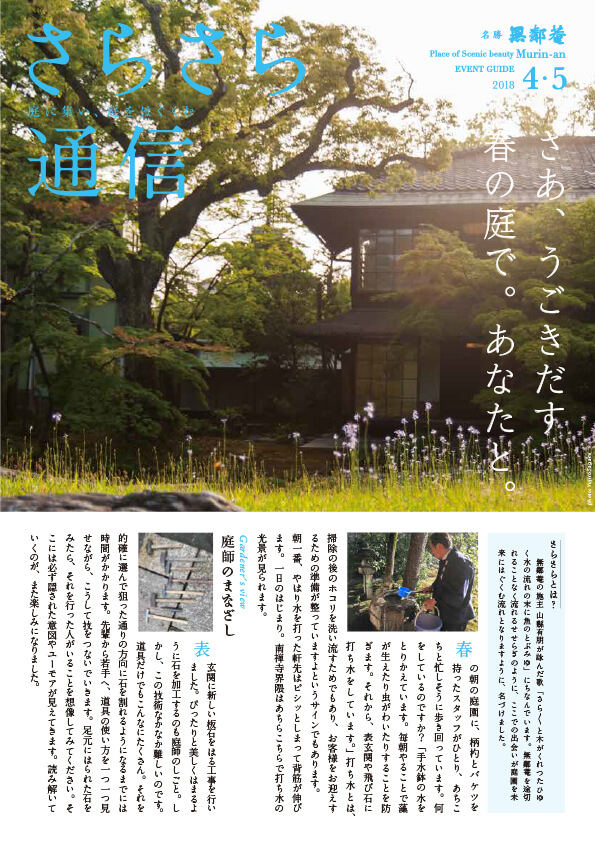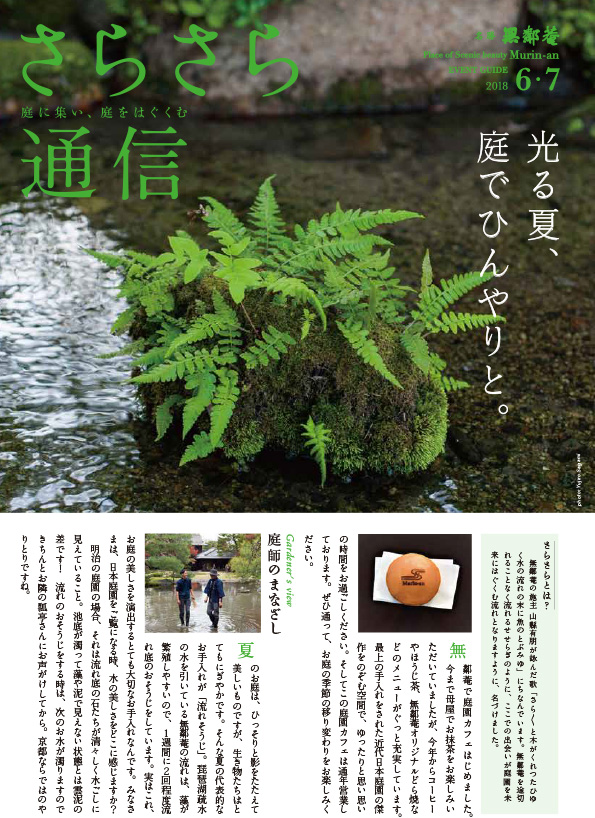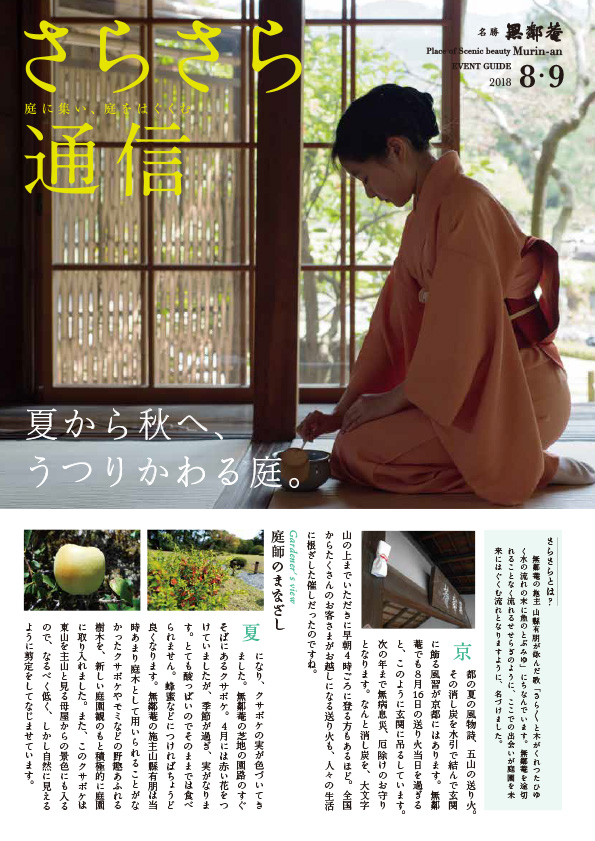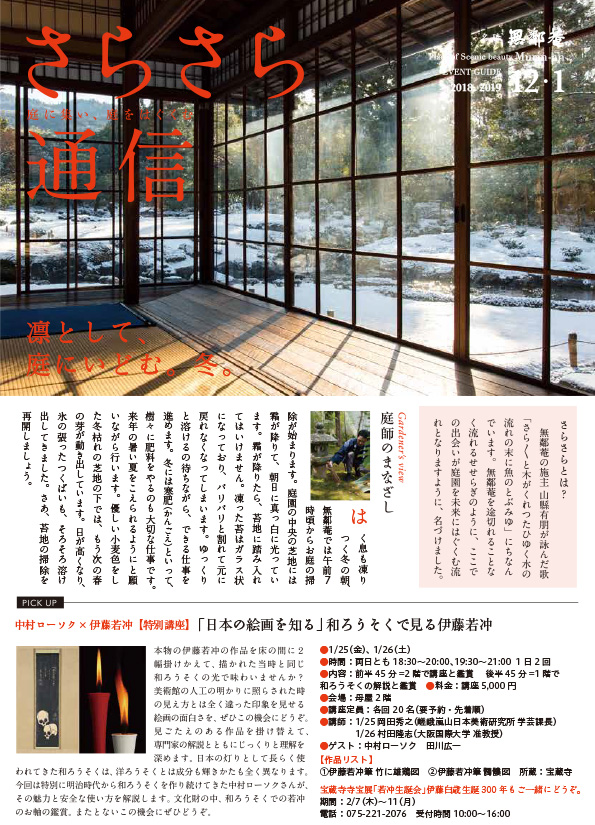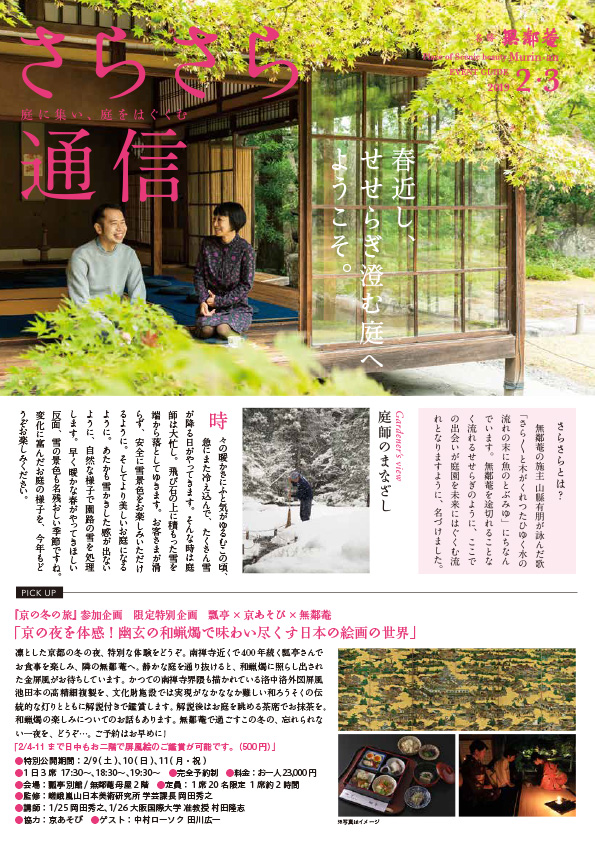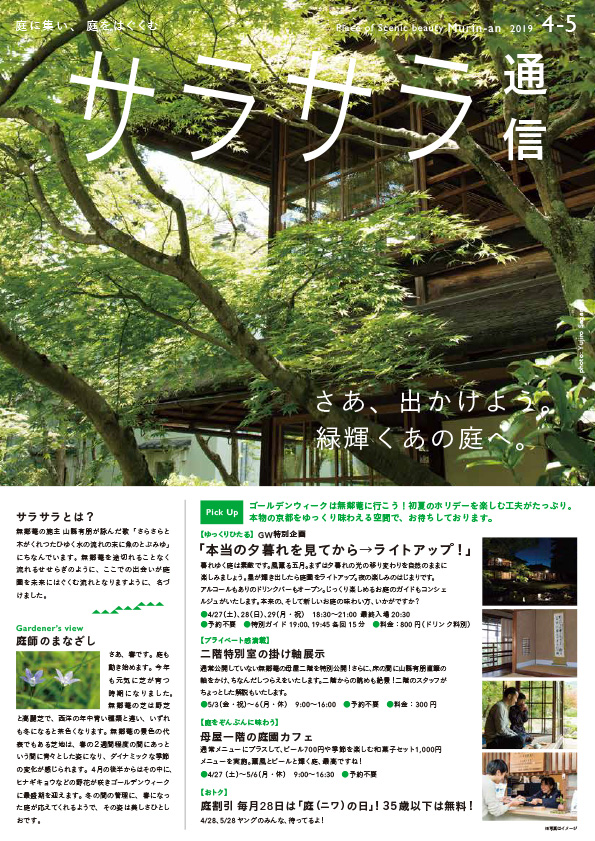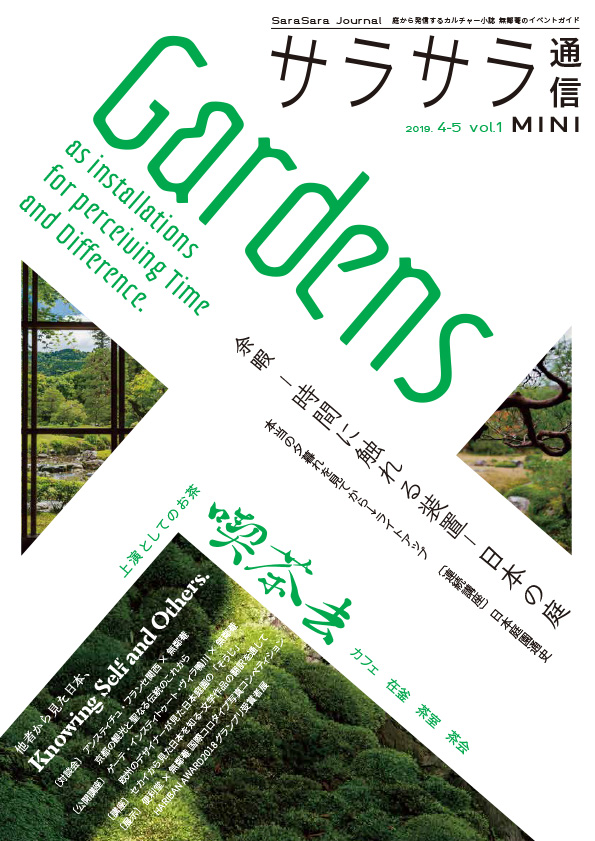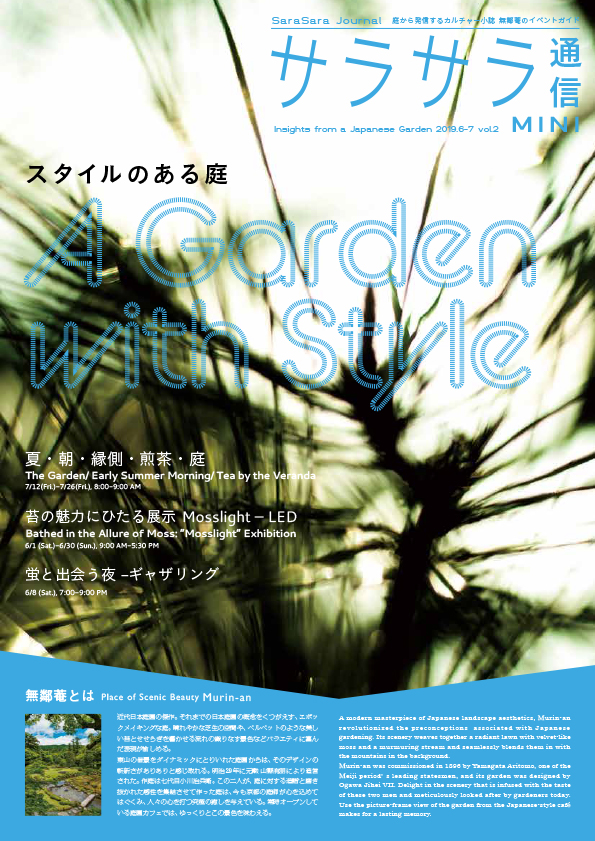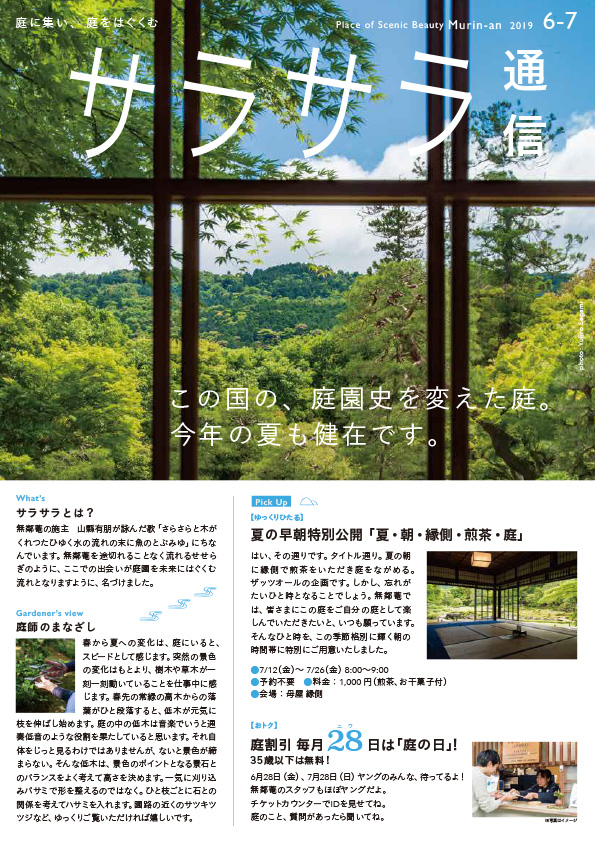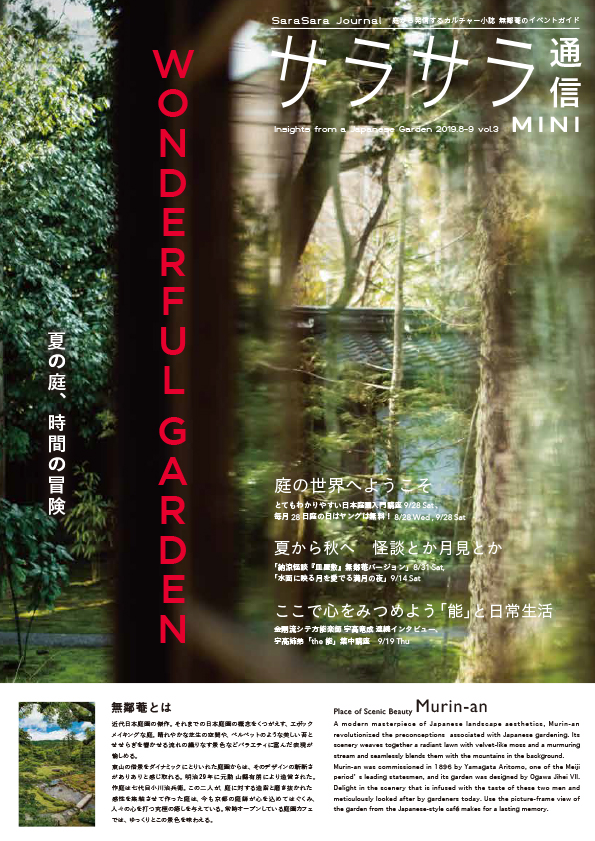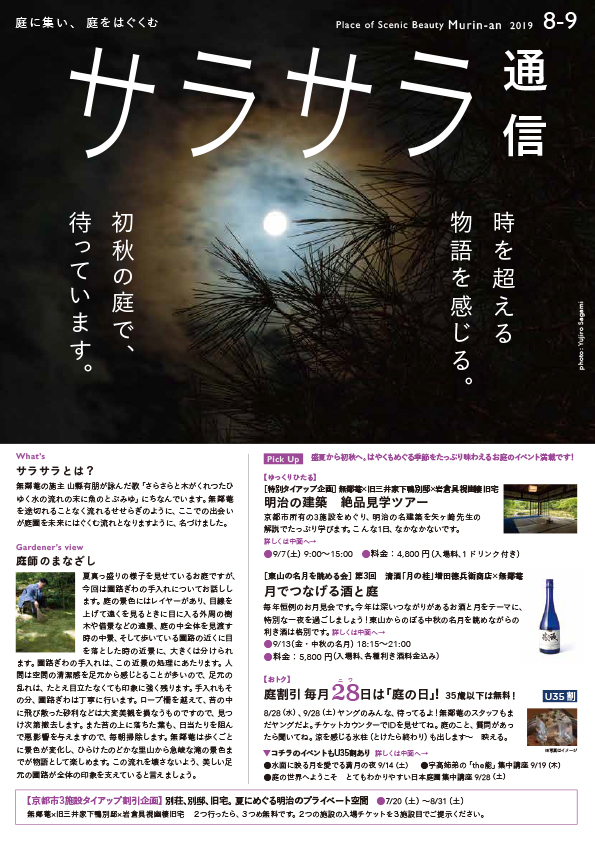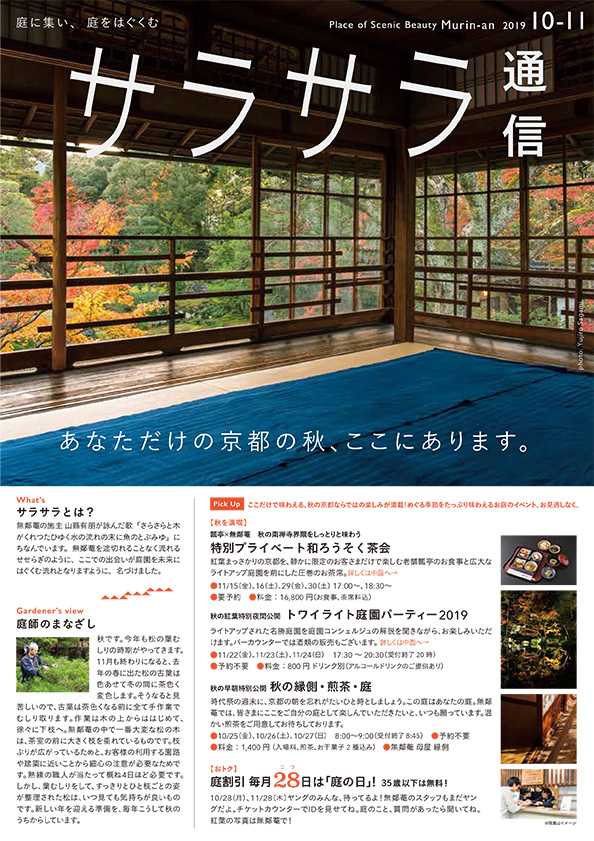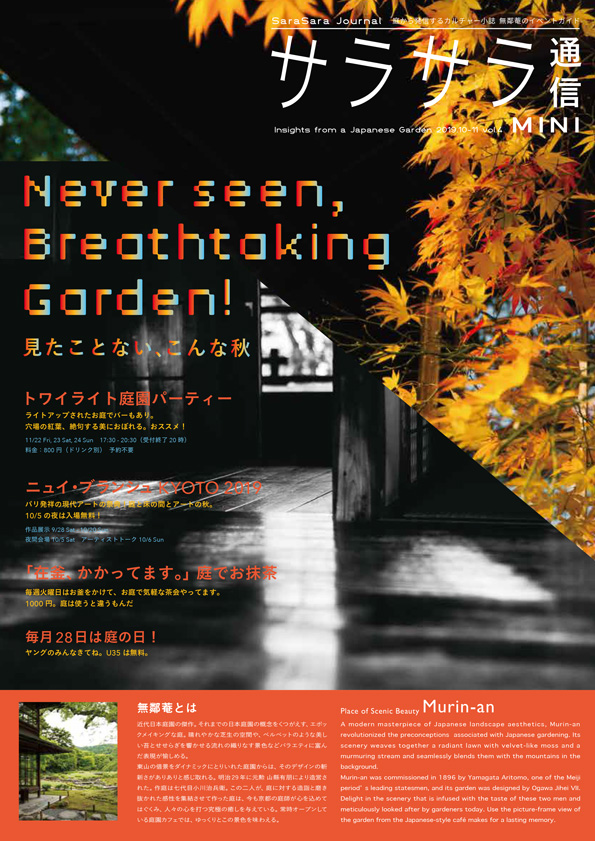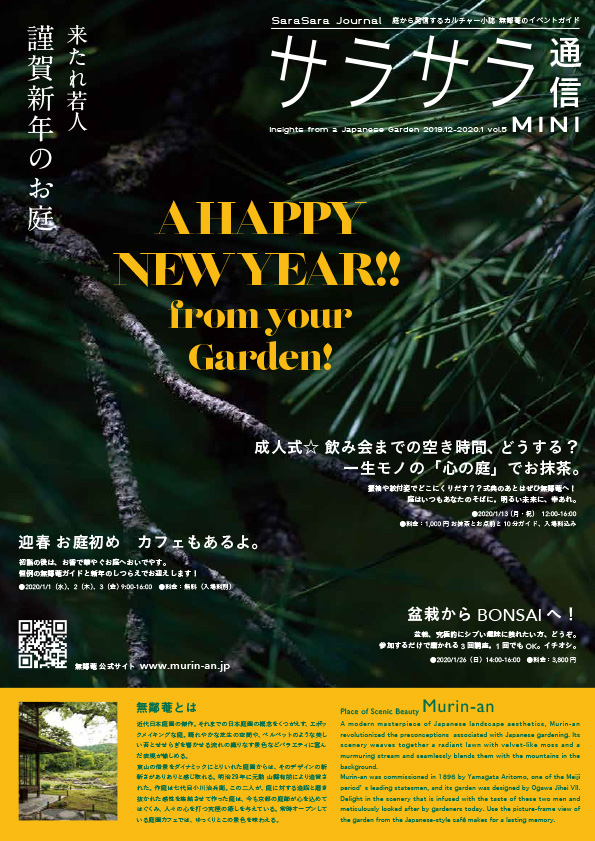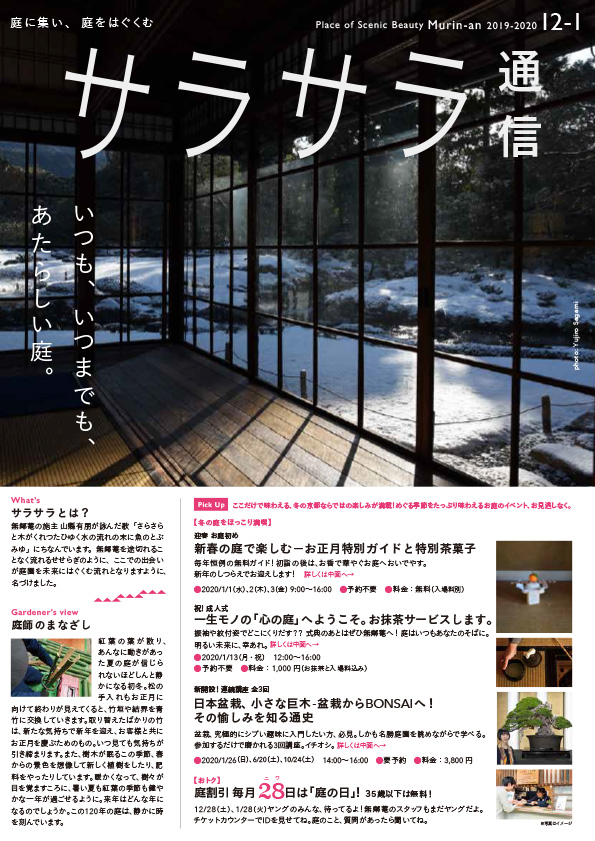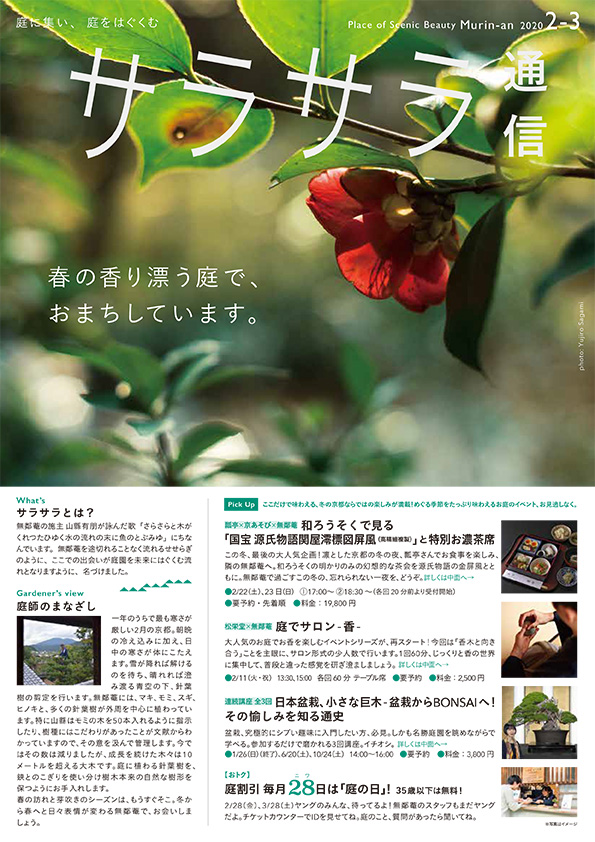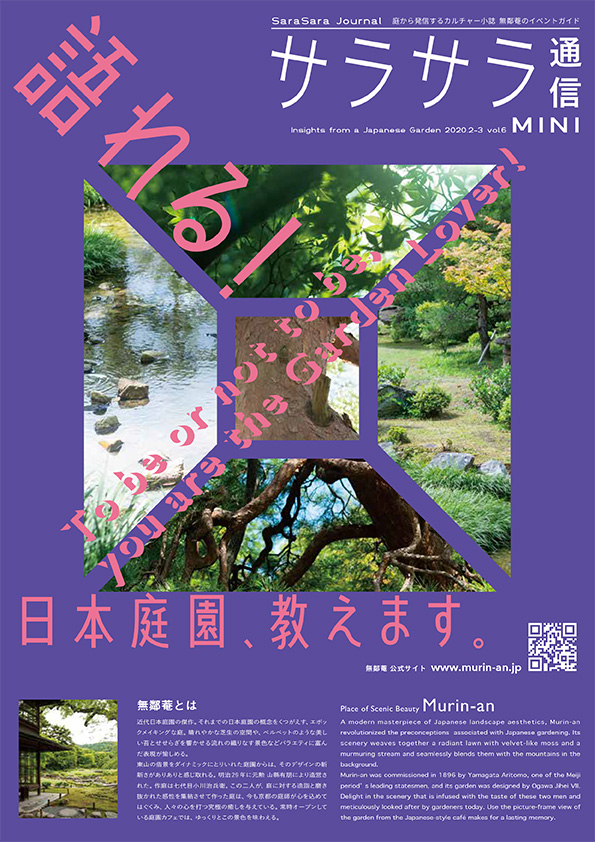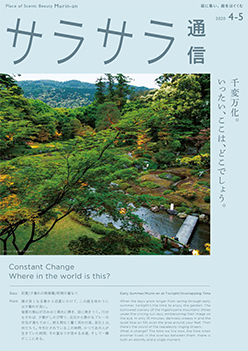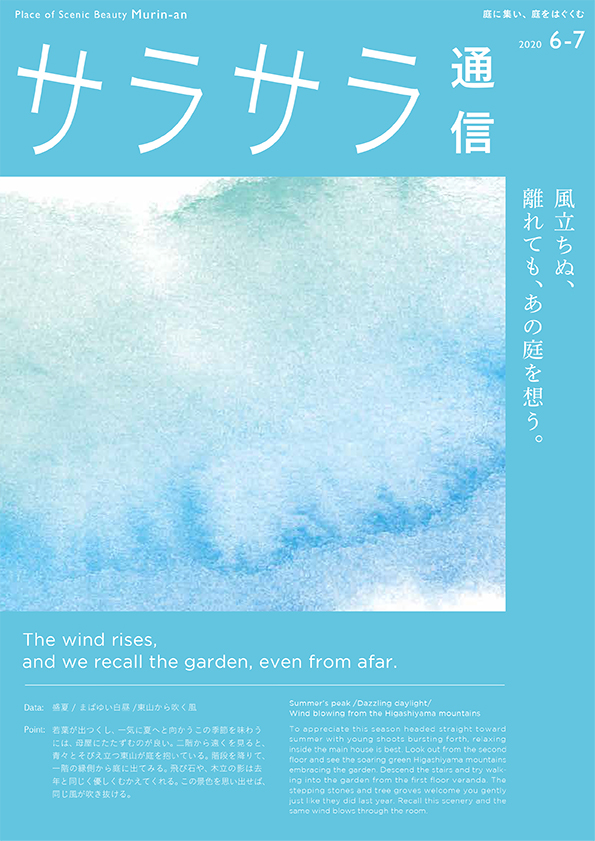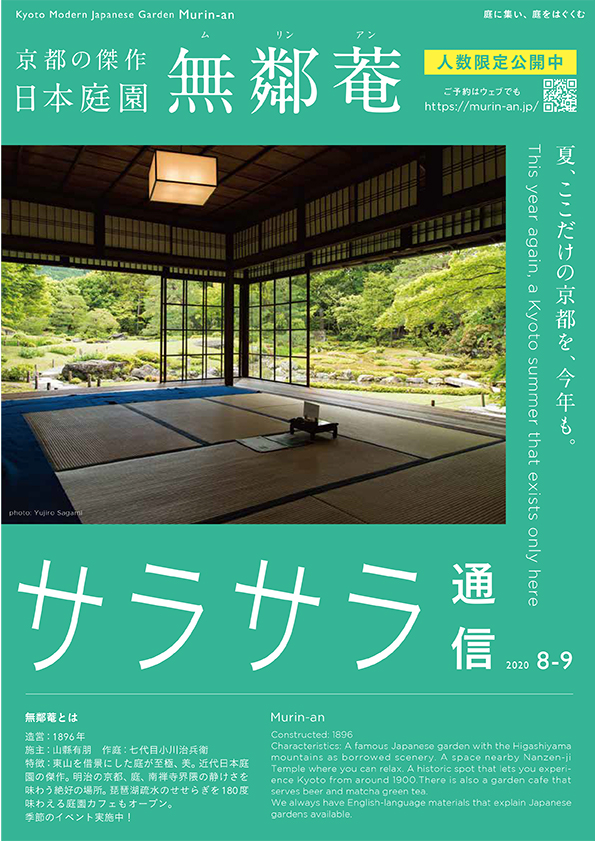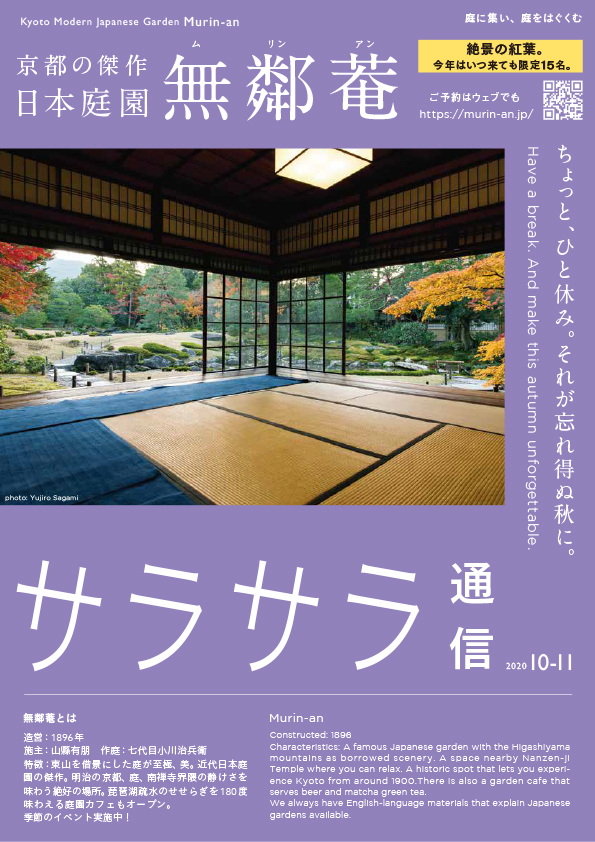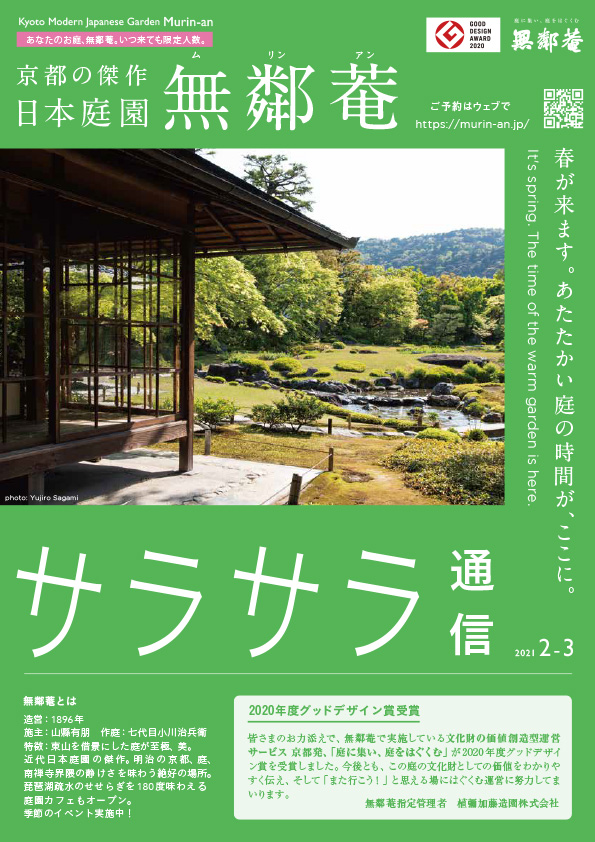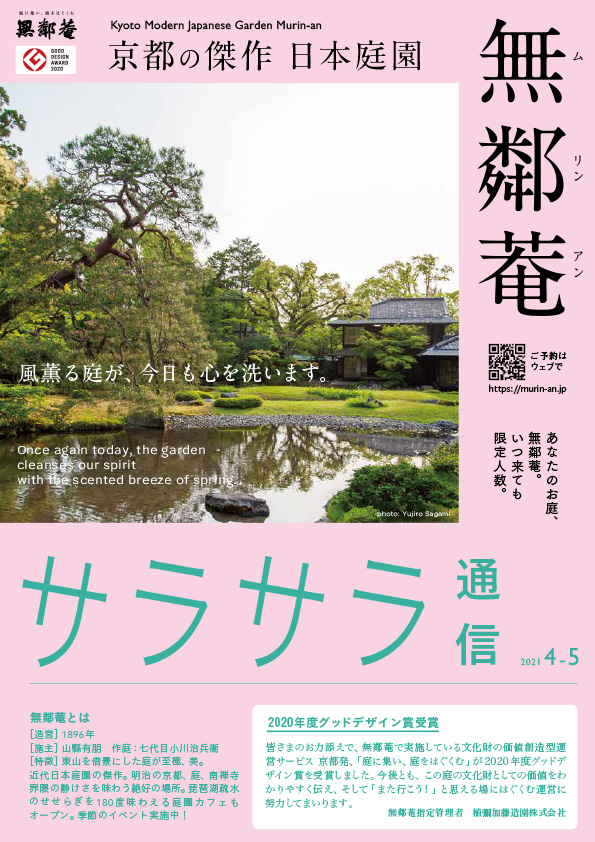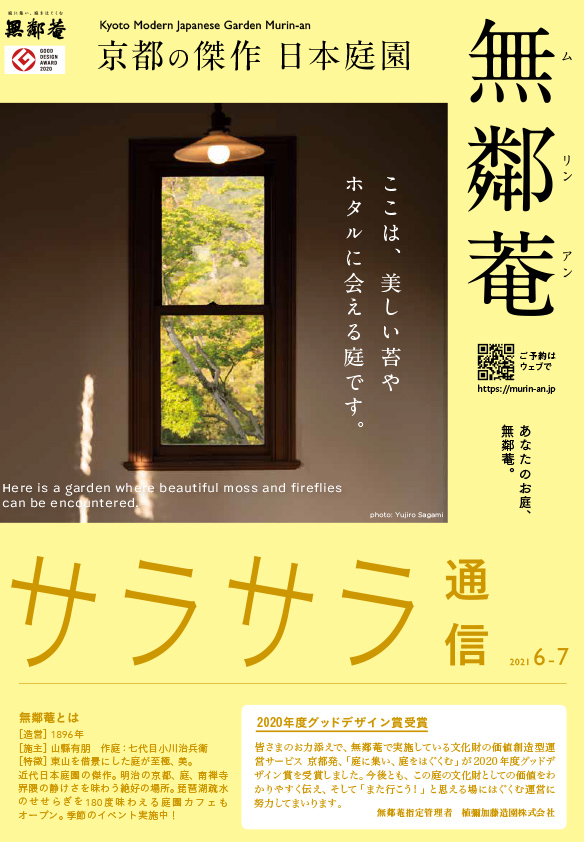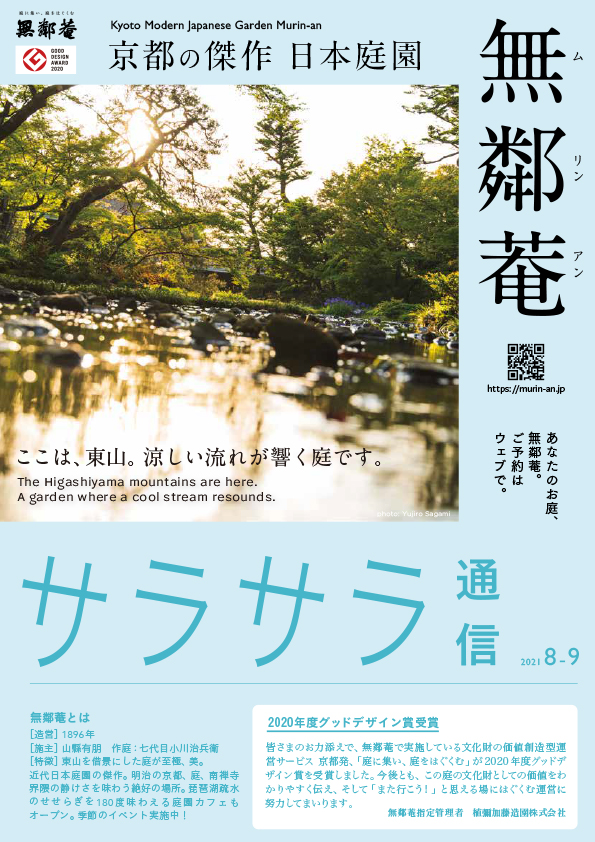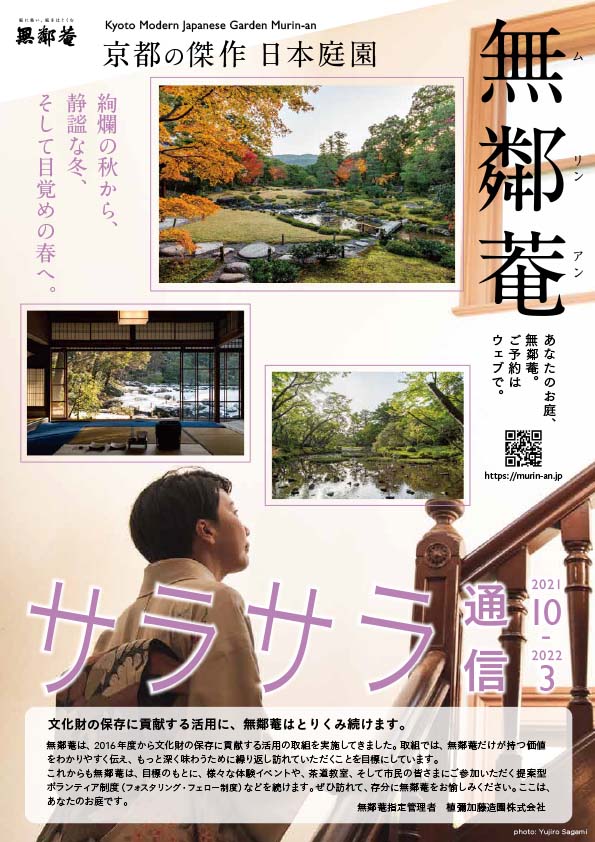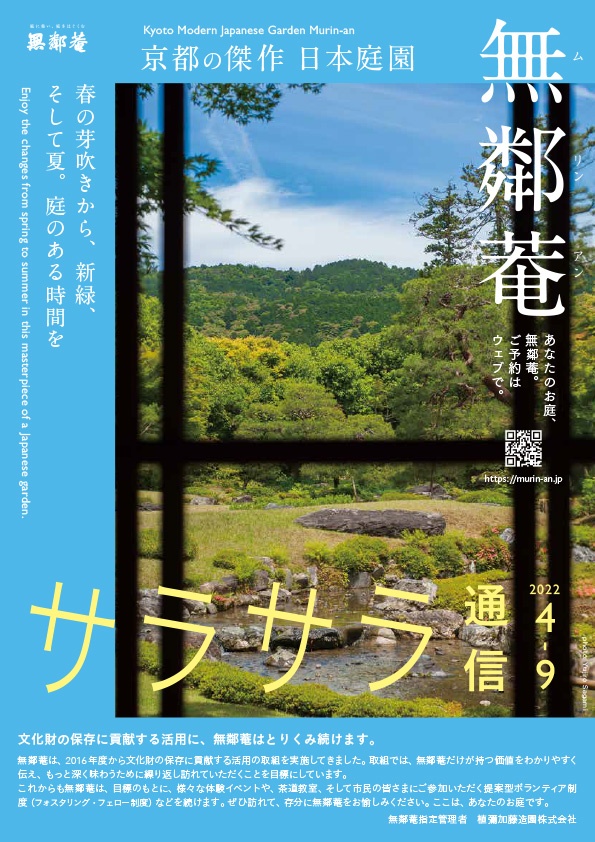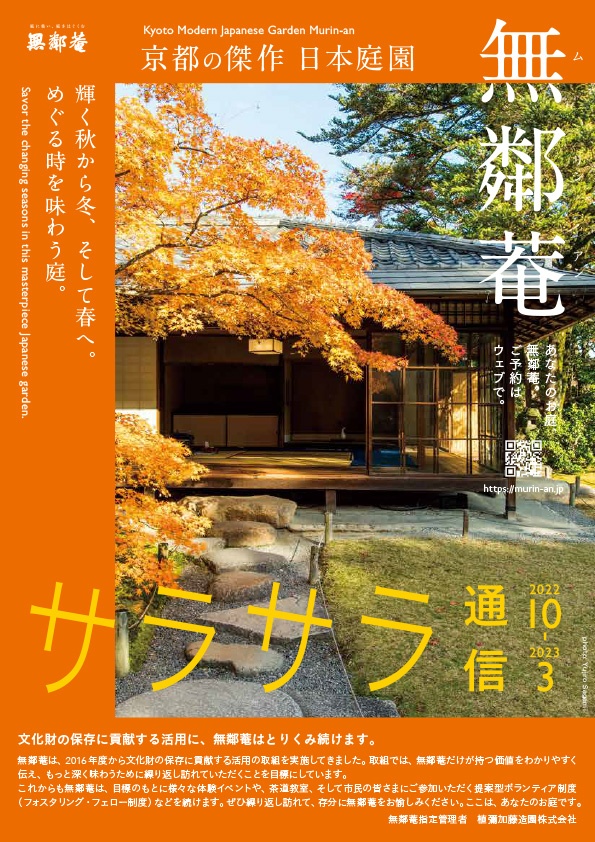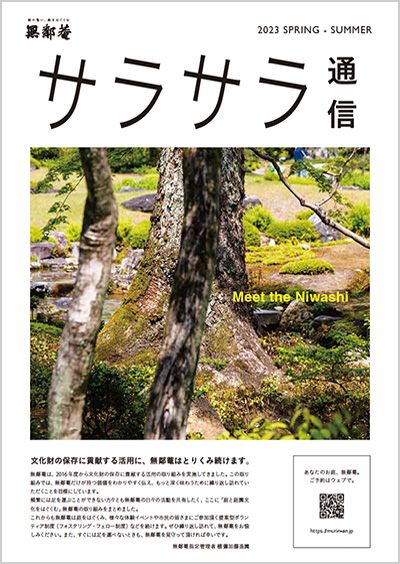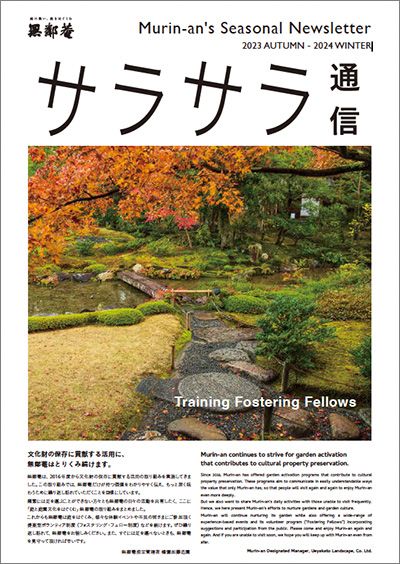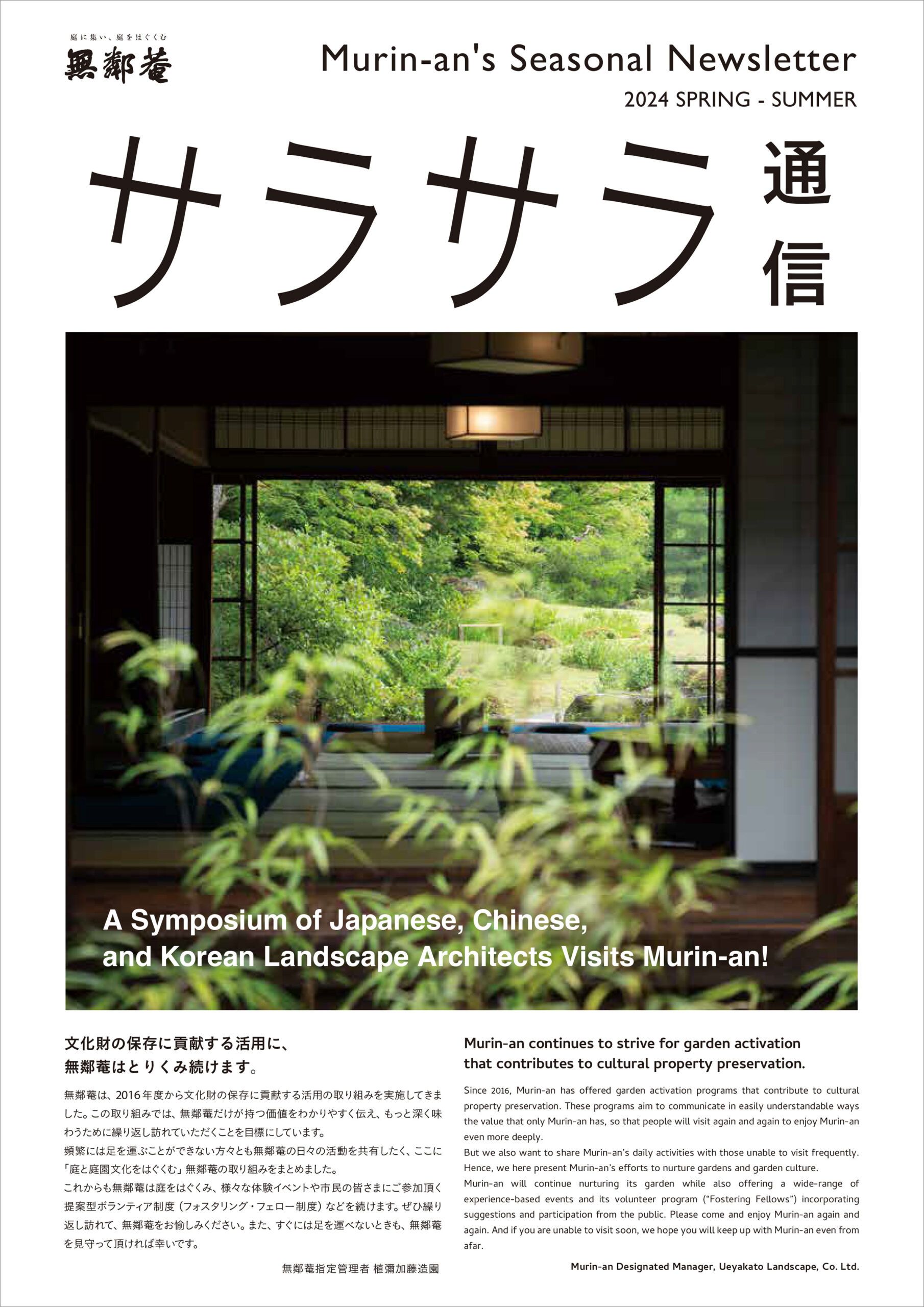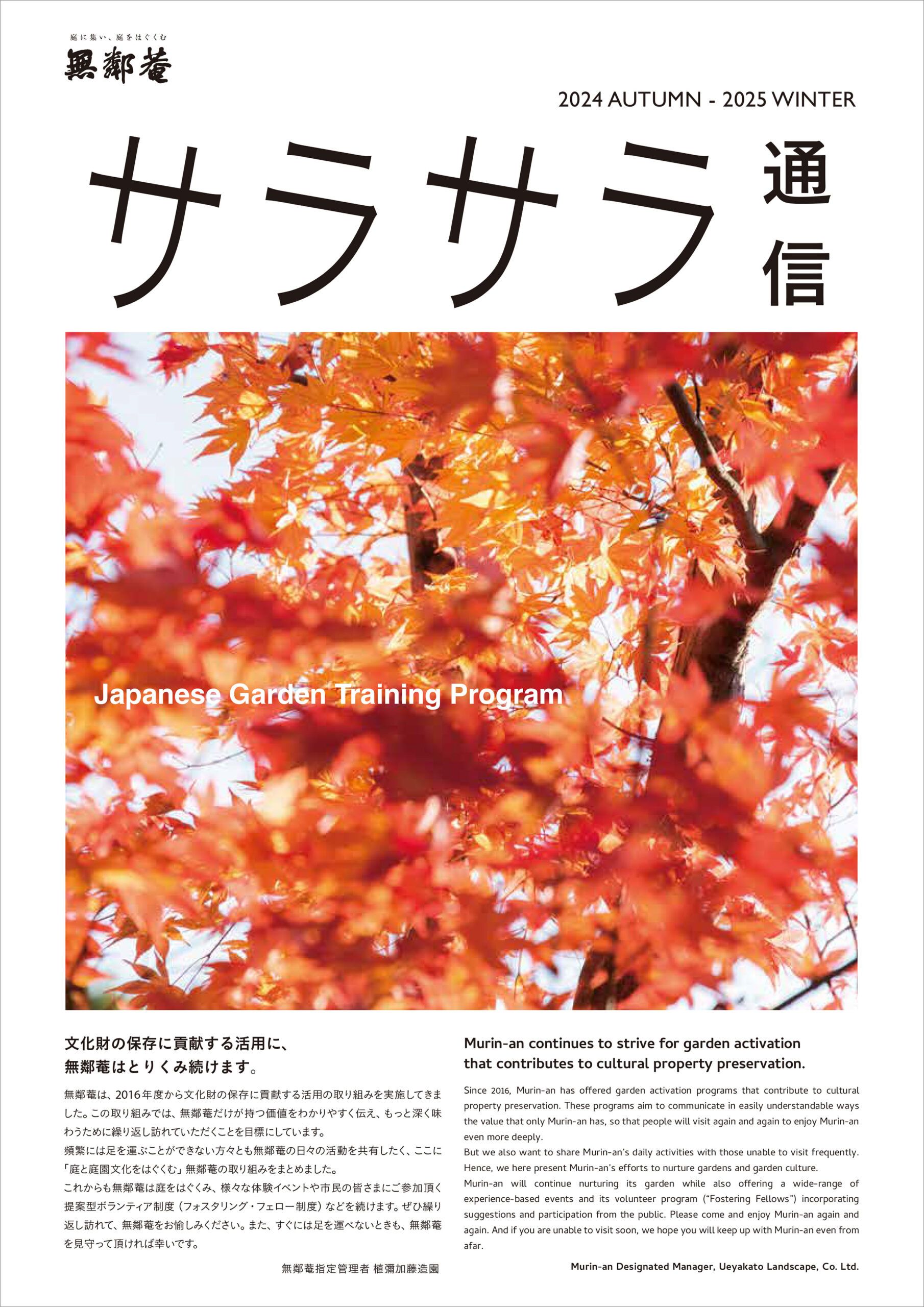Murin-an Periodical
This is the information program of Murin-an Garden.
It provides information on Japanese gardens, invitations to events that help foster the garden and seasonal highlights.
The name of this periodical is Sara-Sara News.
What does “sara-sara” mean? In Japanese, this word is used to evoke a gentle rustle or murmuring sound in nature. We have adopted it from a passage in a poem by Yamagata Aritomo, Murin-an’s original owner. It reads
At the end of a water stream/That murmurs gently as it travels hidden beneath the shade of trees/I see a fish leap
We chose this publication’s title to reflect our hope that, like the ceaseless flow of the murmuring brook flowing around Murin-an, the encounters here will produce a current toward nurturing Japanese gardens for the future.
Why not forget the Kyoto summer heat at a garden so still and quiet it feels like your own private space?
This is Kusakawa-cho, Nanzen-ji. As you pass through a gate that has been sprinkled with cool water, you are greeted by Murin-an, a modern Japanese garden masterpiece. Here at the garden villa of Yamagata Aritomo, one of the elder statesmen of Japan’s Meiji period, time passes slowly, just as it did when he lived there. At this painstakingly maintained Japanese garden, our smiling staff greets you with a friendly “welcome back.” The beautifully unfolding garden slowly changes into a small and quiet pathway with lush moss all around it and an expansive view of the deep mountain scenery that lies beyond the waterfall.
As you gaze upon the garden while taking a break in the main house, the Higashiyama Mountains, still bathing in late summer sunlight, carries the autumn breeze right to you. As you close your eyes to savor the warble of the brook that flows before your feet, you can feel a cool sensation cleanse your psyche.
Why not visit a garden where you can relax to the fullest and create some memories of the end of summer?
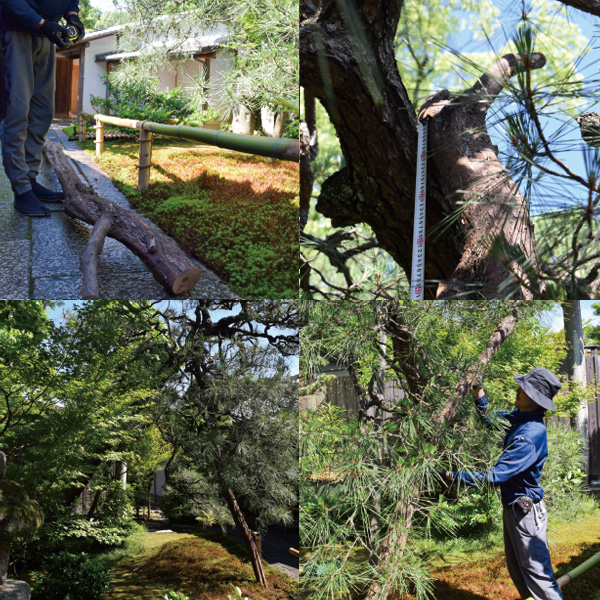 Gardeners visit Murin-an everyday in order to tend to its needs. When a sudden glance causes us to notice an expanding scenery that is cleaner and has a more sharply defined look than yesterday, it is then that we feel the responsibility that comes with this work of being entrusted with scenery.
Gardeners visit Murin-an everyday in order to tend to its needs. When a sudden glance causes us to notice an expanding scenery that is cleaner and has a more sharply defined look than yesterday, it is then that we feel the responsibility that comes with this work of being entrusted with scenery.
In this issue, we will introduce the work of replacing the supports for pine trees. You may have already seen pine trees that are supported by a log to keep their beautifully outstretched branches from breaking. At Murin-an, we also have a pine tree that is supported by such a post. Even when it comes to a “supporting role” like this, it is in a gardener’s nature to want to use material that blends into the garden. The other day we replaced this support with natural wood. This means working with a natural design, so work begins by searching for material of the right length and thickness to support the pine tree. The log’s length is then measured so that it fits properly under the tree. As expected, when the work was finished, the scenery took on a far greater feeling of unity and presence. Please visit Murin-an to savor this painstaking commitment to detail for yourself.
Murin-an Partners Seminar (A Special Roundtable Discussion between Murin-an and a Partner Instructor)
Looking Forward to a Program to Gather People to the Garden through Cooperation between Kyoto’s Young Cultural Leaders and Murin-an
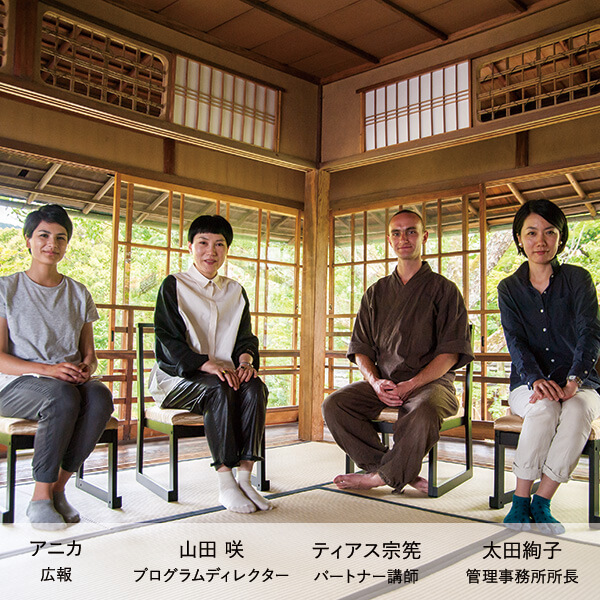 Anika (Public Relations) What are the characteristics of the Murin-an Partners Seminar?
Anika (Public Relations) What are the characteristics of the Murin-an Partners Seminar?
Ota (Murin-an Management Office Director) Gardens originally were cultural intersection points where the worlds of tea, incense and literature all interacted with one another. Our hope is to rise to the challenge of utilizing Murin-an, a designated Place of Scenic Beauty, while also preserving it as a cultural property.
Yamada (Murin-an Program Director) Another characteristic is that Murin-an thinks together with instructors about what doing a program at Murin-an means so that programs are planned to be oriented toward Murin-an from the start. What I found especially interesting when speaking to Tyas in preparation for this seminar series was that he conceives of Japanese tea and the tea ceremony, traditional things whose style is in a sense already established, entirely from his own perspective as “Tyas from Europe who has mastered the tea ceremony.” Even when he talks about Japanese tea, he doesn’t have any manual for what he says, but has always confirmed things with his own body. His basic technique is solid, but beyond that, he has acquired new knowledge on his own through a perspective that has a mold-breaking freedom to it. I felt that if we could communicate Tyas’s perspective to visitors at Murin-an, a garden which is an open cultural intersection point, it could lead to an exciting society that revolves around Japanese culture.
Tyas, could you tell us again how you became interested in Japanese tea?
Tyas (Murin-an Partner Instructor) Sure. I first became interested in Japan through Japanese novels during my high school days in Belgium. In college, I used to lay down a tatami mat in my room and study with a Japanese writing desk on top of it (laughter). I learned at that time about sencha (green tea made from whole tea leaves). Lacking any sort of knowledge in the beginning, I brewed the tea by boiling tea leaves in an iron kettle, but I still thought that Japanese tea was delicious. And when I studied abroad at a Japanese university, I was introduced to my present teacher and learned the Buke style (samurai family-style) of tea ceremony.
Anika How does Murin-an differ from other places you have taught so far?
Tyas There’s no other place that has this open feeling of space. Inside a tearoom, everything is closed off so that you almost forget that you are inside a garden, but the second floor of the main building has such an extensive view and only Murin-an has that feeling of seeming to be outside even though you’re inside. There are also times when I hold tea ceremonies entirely outside along the Kamo River, but that’s different, after all, from holding a tea ceremony in a garden.
Yamada We are very committed to the idea of there being a meaning behind doings things at Murin-an, and we’ve also asked a lot of you in terms of doing something that is more than just a demonstration, but I wonder how you felt about that.
Tyas I don’t feel as though you’ve asked that much of me and I think, to the contrary, that that’s how it should be. Whenever you do anything, I think that unless you do it not just any old way, but with a proper idea in mind and some hope for how you want it to go, it’s pointless. This is a designated cultural property of Kyoto and so I think you must have an attitude that reflects that because you are doing things in a place that has a long history.
Anika I can really feel that your policies and Murin-an’s policies match each other well. What is the content and atmosphere of the seminar like?
Tyas The main theme is the human activities that we can see in Japanese tea, which was created through the particular climate and lifestyle of Japan. The taste, of course, is also important. At every session, we relax and learn together. We use conversation to move the tea ceremony forward and do things together in a convivial atmosphere like that of visiting a friend’s house.
Anika So an open space leads to an open gathering.
Yamada There is also a meaning behind the fact that it doesn’t end with just one session. Our goal is to produce exchange among people who come here repeatedly and to have that result in a new society. We want to get participants who have gotten to know each other to also talk outside Murin-an about how wonderful it is to gather together in Japanese gardens. Another goal is that we hope that people respond to these events by becoming Murin-an members. That’s difficult to achieve on an individual basis, but if we already have a space made up of people who know each other by face, I think that they will have affection for that space. I think that the connections between these people will become a force toward fostering gardens for the future.
Anika So it’s not just a pretty place, but a meeting place.
Yamada Yes. Having memories of “that thing that happened here that one time” entirely changes the way the garden looks and makes it into a living place, doesn’t it? In Japan, there are many cultural institutions that are run like rental spaces. However, German theaters, for example, are actively involved in their performance programs. By clearly indicating to a certain degree what the stance of the institution is in terms of what should be done and for what purpose, we believe a dialogue that transcends position can be produced out of which we can expect a greater diversity to evolve.
Ota That’s right. At Murin-an, the basis of our approach is that we want to make it a space where people can experience the “everyday life cherished by Yamagata Aritomo.” Therefore, when we send out our programs, we also want to send out something that has the fun feeling of daily life, but is still substantial. We hope that Murin-an will become a place where more people can enjoy Japanese gardens in a livelier way.
